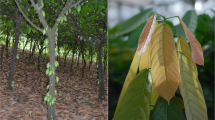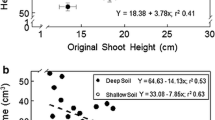Abstract
The future of South Africa’s most important pine species, Pinus patula, is threatened by the pitch canker fungus, Fusarium circinatum. Pinus maximinoi and P. tecunumanii represent two subtropical species that provide an alternative to planting P. patula on the warmer sites of South Africa. Extending the planting range of P. tecunumanii and P. maximinoi to include higher and colder altitude sites will reduce the area planted to P. patula and the risk of F. circinatum. During 2007 progeny trials of P. tecunumanii and P. maximinoi were planted on a sub-tropical and sub-temperate site. Shortly after the establishment of these trials, unusually cold weather conditions were experienced across South Africa (−3°C at the sub-temperate site) resulting in severe mortality. This provided the opportunity to assess the variation in survival as a measure of frost tolerance within these two species to determine whether it could be improved upon through selection. Results indicated that the variation in survival was under genetic control in P. tecunumanii (h 2(0,1) = 0.16, h 2L = 0.27) and P. maximinoi (h 2(0,1) = 0.11, h 2L = 0.23) at the sub-temperate site. Correlations in provenance ranking for survival across sites were high for both species. Moderate correlations in family survival for P. tecunumanii (r = 0.52) were found at the two sites. Improvements in cold tolerance can thus be made in both species extending their planting range to include greater areas planted to P. patula thereby limiting the risk of F. circinatum.





Similar content being viewed by others
References
Aldrete A, Mexal JG, Burr KE (2008) Seedling cold hardiness, bud set, and bud break in nine provenances of Pinus greggii Englm. For Ecol Manag 255:3672–3676
Chambers PGS, Borralho NMG, Potts BM (1996) Genetic analysis of survival in Eucalyptus globulus ssp globulus. Silvae Genetica 45:107–112
Dickerson GE (1969) Techniques for research in quantitative animal genetics. In: Techniques and procedures in animal science research. American Society of Animal Science, Albany, NY, pp 36–79
Dieters MJ, White TL, Hodge GR (1995) Genetic parameter estimates for volume from full-sib tests of slash pine (Pinus elliottii). Can J For Res 25:1397–1408
Dong J, Yu S, Lin Y, Wang Q, Lu A, Feng J, Liu Y, Man S, Qu Y (2009) Selection of superior provenance of eastern white pine by cold resistance. J Northeast For Uni 37:4–6
Duncan PD, White TL, Hodge GR (1996) First-year freeze hardiness of pure species and hybrid taxa of Pinus elliottii (Engelman) and Pinus caribaea (Morelet). New For 212:223–241
Dvorak WS (1986) Provenance/progeny testing of Pinus tecunumanii. In: Proceedings of IUFRO breeding theory, progeny testing and seed orchard management. Williamsburg, VA. October 12–17, pp 299–309
Dvorak WS, Hodge GR, Gutiérrez EA, Osorio LF, Malan FS, Stanger TK (2000a) Pinus tecunumanii. In: Conservation and testing of tropical and subtropical forest tree species by the CAMCORE Cooperative. College of Natural Resources, North Carolina State University, pp 188–209
Dvorak WS, Gutiérrez EA, Galpare WJ, Hodge GR, Ororio LF, Bester C, Kikuti P (2000b) Pinus maximinoi. In: Conservation and testing of tropical and subtropical forest tree species by the CAMCORE Cooperative, College of Natural Resources, NCSU, Raleigh, NC, USA, pp 107–127
Dvorak WS, Potter KM, Hipkins VD, Hodge GR (2009) Genetic diversity and gene exchange in Pinus oocarpa, a Mesoamerican pine with resistance to the pitch canker fungus (Fusarium circinatum). Int J Plant Sci 170:609–626
Gapare W, Hodge GR, Dvorak WS (2001) Genetic parameters and provenance variation of Pinus maximinoi in Brazil, Colombia, and South Africa. For Genetics 8:159–170
Hodge GR, Dvorak WS (2000) Differential responses of Central American and Mexican pine species and Pinus radiata to infection by the pitch canker fungus. New For 19:241–258
Hodge GR, Dvorak WS (2007) Variation in pitch canker resistance among provenances of Pinus patula and Pinus tecunumanii from Mexico and Central America. New For 33:193–206
Howe K (2006) Identifying candidate genes associated with cold adaptation in Douglas-fir using DNA microarrays. Oregon State University in partial fulfillment of Master of Science
Kietza JE (1988) Pinus maximinoi: a promising species in South Africa. South Afr For J 145:33–38
López-Upton J, White TL, Huber DA (1999) Taxon and family differences in survival, cold hardiness, early growth, and rust incidence of Loblolly pine, Slash pine and some Pine hybrids. Silvae Genetica 48:303–313
Mahalovich MF, Burr KE, Foushee DL (2006) Whitebark pine germination, rust resistance and cold hardiness among seed sources in the inland northwest: planting strategies for restoration. USDA forest service proceedings RMRS-P-43, pp 91–101
Malan FS (1994) The quality and wood properties of 4 provenances of South-African-grown Pinus tecunumanii. Ann Sci For 51:203–212
Malan FS (2006) The wood properties and sawn-board quality of South African-grown Pinus maximinoi (HE Moore). South Afr For J 208:39–48
Mitchell RG, Wingfield MJ, Hodge GR, Steenkamp ET, Coutinho TA (2011) Selection of Pinus spp. in South African for tolerance to infection by the pitch canker fungus. New For (in print) http://www.springerlink.com/content/j02181n158286311
Rehfeldt GE (1989) Genetic variances and covariances in freezing tolerance of lodgepole pine during early winter acclimation. Silvae Genetica 38:133–137
Roux J, Elsenberg B, Kanzler A, Nel A, Coetzee V, Kietzka E, Wingfield MJ (2007) Testing of selected South African Pinus hybrids and families for tolerance to the pitch canker pathogen, Fusarium circinatum. New For 33:109–123
SAS Institute (2004) SAS® 9.1.3 ETL studio: user’s guide. Cary, NC, USA
South D, Donald DGM, Rakestraw JL (1993) Effect of nursery culture and bud status on freeze injury to Pinus taeda and P. elliottii seedlings. S Afr For J 166:37–46
Tinus RW, Sword M, Barnett JP (2002) Prevention of cold damage to container-grown longleaf pine roots. General Technical Report SRS-56, Ashville, NC, USDA Forest Service, Southern Research station, pp 55–57
Acknowledgments
We thank Komatiland Forests for making available the data from these trials for publication.
Author information
Authors and Affiliations
Corresponding author
Rights and permissions
About this article
Cite this article
Mitchell, R.G., Wingfield, M.J., Hodge, G.R. et al. Susceptibility of provenances and families of Pinus maximinoi and Pinus tecunumanii to frost in South Africa. New Forests 44, 135–146 (2013). https://doi.org/10.1007/s11056-012-9306-z
Received:
Accepted:
Published:
Issue Date:
DOI: https://doi.org/10.1007/s11056-012-9306-z




